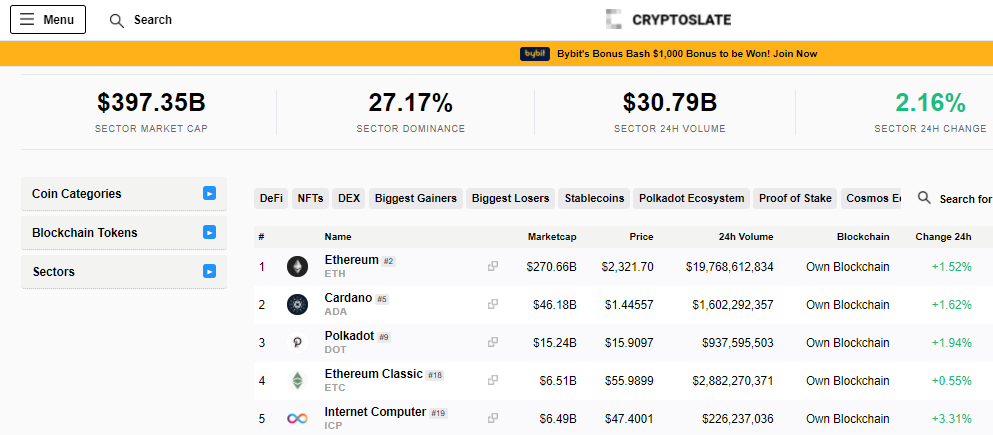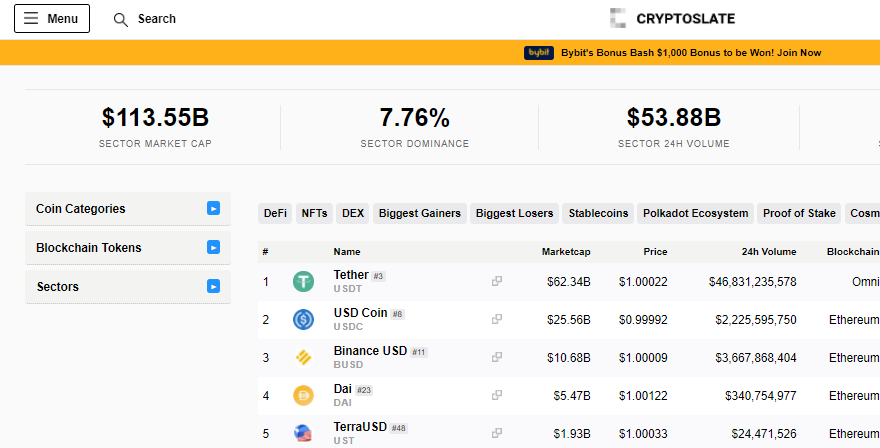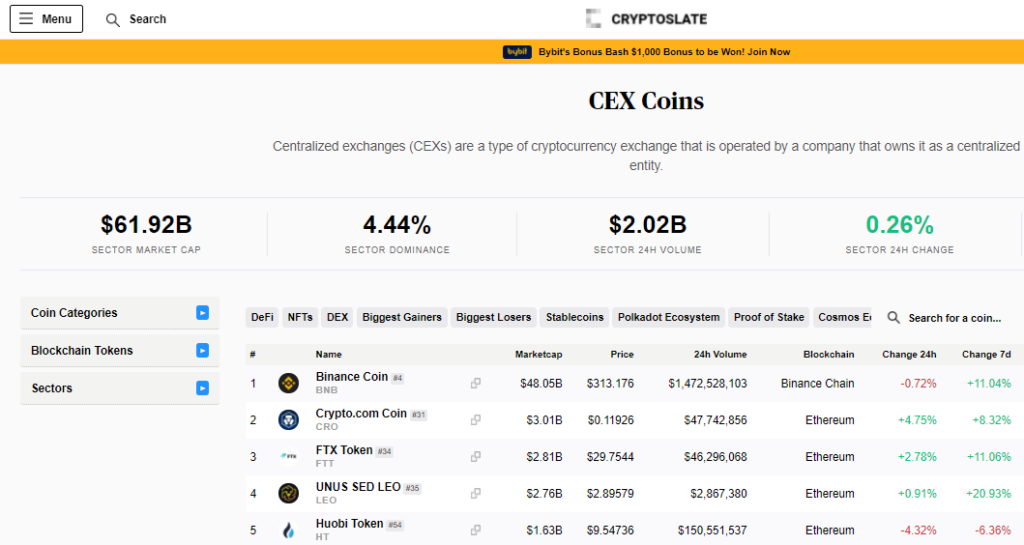CryptoSlate is one of the most intriguing sites for cryptocurrency news, data, and analysis, directories, events, and more. It is an efficient way for investors to gain a glimpse into the cryptocurrency universe.
One section of the web page that’s particularly insightful is the statistics on the most dominant sectors in cryptocurrencies. While the site doesn’t necessarily rank these, viewers can quickly tell which are more prominent than others based on the numbers.
At the time of writing, CryptoSlate classifies the following four sectors as the most influential:
- Smart contracts (27%)
- Stablecoins (7%)
- Exchange utility tokens (6%)
- DeFi (5%)
In this article, we’ll briefly cover each of these. For investors, this should be a helpful overview of which projects are gaining the most traction and where they should potentially put their money.
Smart contracts
A smart contract is a coded contract on a blockchain designed to execute autonomously when certain conditions have been fulfilled. This invention allows for a myriad of transactions to happen in a permissionless nature without third-party verification, which is often costly and time-consuming.

Ethereum is the largest smart contract network and has continuously proven to foster numerous applications in the space.
For instance, the booming NFT (non-fungible token) market is aided in part with smart contracts allowing users to prove ownership of digital assets adequately.
Uniswap, currently the biggest decentralized exchange (which also happens to be deployed on Ethereum), utilizes smart contracts for a number of purposes, like managing liquidity pools without a centralized system.
Overall, coins with smart contract functionality can perform several applications and serve specific niches. Examples of projects tipped to increase in value within this category potentially include the likes of Polkadot, Cardano, Ethereum, Stellar, VeChain, and the list goes on.
Stablecoins

Stablecoins have had a massive influence on how cryptocurrencies operate. A stablecoin is a token pegged on a 1:1 basis to maintain a stable price with another fiat currency, commodity, or algorithmic collateral.
The stablecoin is always priced at $1 (or almost exactly $1) or one unit of an equivalent currency. For instance, Tether, the largest-capped stablecoin presently, is supposed to keep $1 in reserves for every minted USDT token.
Digital assets can easily fluctuate a few percent in price regularly. By owning a stablecoin, traders can enjoy the benefits of having digital money without worrying about erratic differences in price when exchanging, as would be the case with Bitcoin and the like.
As many exchanges do not accept deposits using fiat currencies, stablecoins work as the alternative being crypto-based, which is another advantage. Despite being highly controversial presently, Tether is a substantial contributor to liquidity in the markets and is perhaps the pioneer of these tokens.
Other prominent stablecoins currently are TrueUSD, Binance USD, USD Coin, TerraUSD, Gemini Dollar, etc.
Exchange utility tokens
Utility tokens are cryptocurrencies offered by exchanges (centralized and decentralized), allowing their customers several special facilities. For starters, many provide incentives to clients through discount reductions in their overall trading volume.


Users can make purchases to related services of a particular exchange only payable with that utility token, increasing the trading activity and ultimately bringing in more revenue and business opportunities.
Such coins are essentially the fuel to an exchange’s ecosystem, allowing them to offer several interesting crypto-related services.
For instance, Binance Coin (BNB), the largest-capped centralized exchange utility token, allows Binance customers up to 25% off their trading fees, joining mining pools, investing in initial coin offerings, staking, crypto loans, etc.
CRO, the utility token of the Crypto.com exchange, also provides trading fee discounts, in addition to discounts for purchasing mobile airtime, sending crypto, buying from selected merchants, and staking.
For an example of a decentralized exchange utility token, let’s look at PancakeSwap’s CAKE. This cryptocurrency is one of the bridges in creating liquidity within the exchange through user-generated pools and external liquidity providers.
CAKE holders can also participate in staking with attractive annual yields and PancakeSwap’s lotteries, where they can receive even more CAKE.
DeFi (decentralized finance)
We could think of decentralized finance as an offspring of smart contracts and the methods of allowing transactions without intermediaries. The simplest way of defining DeFi imagines everything about the current, traditional, and centralized finance system but in the opposite.

Instead of a centralized exchange like Coinbase or Binance, we can have decentralized exchanges which can source liquidity through user participation without needing a formal liquidity provider.
Rather than going through the tedious and costly process of acquiring a loan from a bank, various DeFi applications exist where traders can borrow using their own coins more quickly, cheaply, and efficiently.
In essence, DeFi seeks to cut out the middlemen in as many financial transactions as possible. Popular DeFi platforms, aside from exchanges and lending services, also include saving accounts, yield farming, wallets, etc.
Amazingly, many of the DeFi coins use Ethereum for much or all of their deployment. Examples of projects in this industry comprise Uniswap, Chainlink, Wrapped Bitcoin, Dai, Aave, etc.
Final word
Presently, at least 5000 cryptocurrencies exist, which is quite an astounding number. This incredible diversity does make it difficult to distinguish between what is truly valuable and what is not.
The gist of this article was an overview of which projects in this assorted space are the potential gems so investors can make smarter decisions about their investments.







